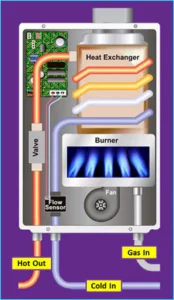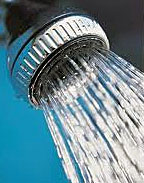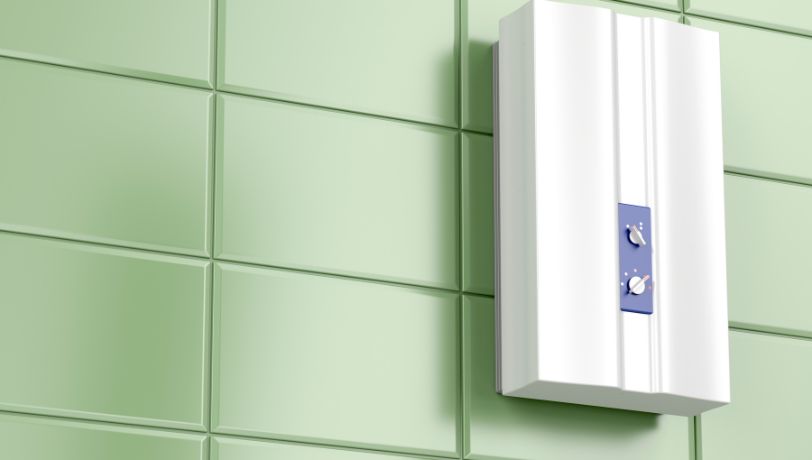Continuous Water Heater – Tankless Water Heater NZ – Gas Hot Water System – Gas Water Heater
How Does a Continuous Water Heater – Tankless Water Heater Work?
A tankless water heater, also known as tankless water heater NZ (continuous water heater), works when you open a hot water tap and a sensor detects the gas hot water flow.
The gas water heater burner fires and the heat exchanger warms the flowing gas hot water.
Some tankless water heater NZ (continuous water heater) units work with a secondary gas hot water heat exchanger to pre-heat the gas hot water, using heat from the tankless water heater NZ (continuous water heater) exhaust gases.
A thermostat regulates the amount of gas that goes to the tankless water heater NZ (continuous water heater) burner, maintaining the pre-set gas hot water temperature.
Gas Hot Water Cylinder – Gas Water Heater Tank
![]() A gas hot water cylinder (gas water heater tank) works by heating gas hot water and storing it until needed.
A gas hot water cylinder (gas water heater tank) works by heating gas hot water and storing it until needed.
Gas hot water is drawn from the top of the gas hot water cylinder (gas water heater tank) and replaced with cold water at the bottom because gas hot water rises.
When the gas hot water cylinder (gas water heater tank) water temperature drops below the gas water heater thermostat set point, the gas hot water system works by having the gas water heater burner run until the temperature recovers to the set point.
Electronically Controlled Continuous Water Heater – Tankless Water Heater NZ
At the heart of most modern continuous gas hot water system types is an Electronic Control Unit (ECU) that controls how the gas flows through the tankless water heater NZ (continuous water heater).
The ECU controls all of the functions of the tankless water heater NZ (continuous water heater), including temperature control, ignition, gas flow, and modulation.
It is also responsible for safety, with a flame sensor and automatic gas cut-off in the event of a problem.
Turning on Your LPG Gas Hot Water System
When you turn on a hot water tap anywhere in your home, a flow sensor connected to the ECU detects the gas hot water flow through the tankless water heater NZ (continuous water heater), and the gas hot water heating begins.
A slow leaking tap is not enough flow to start the LPG gas hot water system.
However, leaky water pipelines and gas hot water system repairs require immediate inspection.
Some tankless water heater NZ (continuous water heater) models have a combustion fan that draws air for combustion.
At the same time, the ECU starts the gas flow via a solenoid gas valve and triggers the gas water heater igniter.
The gas water heater igniter sparks until the flame sensor detects a flame.
If the tankless water heater NZ (continuous water heater) fails to light within a few seconds, the ECU shuts down the gas flow to prevent any unsafe accumulation of gas.
The Continuous Water Heater – Tankless Water Heater NZ Heating Process
 The gas water heater burner applies heat to the gas hot water heat exchanger that the water flows through the tankless water heater NZ (continuous water heater).
The gas water heater burner applies heat to the gas hot water heat exchanger that the water flows through the tankless water heater NZ (continuous water heater).
The course of the water through a continuous flow gas hot water system is typically a serpentine pattern, allowing the water to absorb as much heat as possible from the walls of the gas hot water heat exchanger. (see image)
Some tankless water heater NZ (continuous water heater) models have a secondary gas hot water heat exchanger to pre-heat the water, using the heat from the gas water heater burner exhaust gases.
This is often called a “condensing” model.
The advantage of these gas hot water system types is that they provide even greater energy efficiency; however they tend to have a higher purchase price than standard tankless water heater NZ (continuous water heater) models.
Controlling the Continuous Water Heater – Tankless Water Heater NZ Temperature
As the flow rate and temperature of the incoming water can vary, the ECU modulates the amount of gas that goes to a tankless water heater NZ (continuous water heater).
This modulation of the gas keeps the gas hot water at a constant temperature.
This functionality is based on a gas water heater temperature sensor on the exit side of the gas hot water heat exchanger.
Some tankless water heater NZ (continuous water heater) models have gas water heater temperature controllers that allow the user to select a gas water heater temperature and others are factory pre-set.
These gas water heater controllers can be located on the tankless water heater NZ (continuous water heater) or wired to a remote location like a kitchen or bathroom.
The ECU takes the gas water heater controller’s input to modulate the gas flow, keeping the gas hot water at the user’s desired temperature.
Most tankless water heater NZ (continuous water heater) models come with their maximum gas hot water temperature pre-set in the factory.
This is a safety precaution to help prevent possible scalding.
What to Look for When Buying a Continuous Water Heater – Tankless Water Heater NZ
There are many manufacturers of tankless water heater NZ (continuous water heater) models, each offering different models including both LPG and natural gas water heater options.
There can be variations in gas water heater features, functionality, and operation so always consult the specific manufacturer’s information when making a gas water heater purchase selection or other decision.
Always consult the tankless water heater NZ (continuous water heater) model owner’s manual for advice on safe operation and maintenance.
Don’t Calculate by Number of People or Bathrooms
The gas water heater sizing information available can be confusing because manufacturers and suppliers are trying to provide a simple answer to what can be a complicated question.
Some suggest that you should use the number of bathrooms in your home to calculate the size of tankless water heater NZ (continuous water heater) that you need, while others recommend you consider the number of people in your family.
In some cases, a worst-case scenario is used to recommend the size of the tankless water heater NZ (continuous water heater) required, and this can result in a much higher gas water heater consumption calculation than your actual gas hot water use.
Buying Too Large Wastes Money
The result is that many people end up buying a larger tankless water heater NZ (continuous water heater) system than they need.
This costs them extra money when they buy the tankless gas hot water system and will, in many instances, increase the ongoing operating costs.
Factors to Really Consider When Choosing a Tankless Gas Hot Water System (Tankless Gas Water Heater)
Simultaneous shower use is one of the fundamental determining factors when choosing a tankless gas hot water system (tankless gas water heater).
The key is not only how many people are in your home, but how and when they use gas hot water. For example:
- Do they all take showers at the same general time of day?
- Do they take showers simultaneously in different bathrooms?
- Do the showers have WELS 3 Star Rated Showerheads (maximum 9L/Min) or standard 18 to 25L/Min showerheads?
- Do some prefer baths which use more gas hot water? And if so, is the bath or spa oversized, requiring even more gas hot water?
- Is the washing machine run using hot or warm water, and is it run while people are showering?
- Is your dishwasher connected to the cold or hot water? And if hot, is it run while the gas hot water is being used elsewhere in the house?
Showers are the Key Consideration When it Comes to Gas Hot Water Use
 Showers use the most gas hot water in a home.
Showers use the most gas hot water in a home.
People generally shower for 5 to 10 minutes.
Assuming you have a 3 Star water-saving shower head and you mix some cold water with the hot, the typical hot water consumption would probably be around 7 litres per minute.
This means that an 8-minute shower uses 56 litres of water per shower when using a water-saving shower head, or 224 litres for a family of four.
Using a non water efficient showerhead can increase water usage significantly, between 12 – 22 litres per minute.
Therefore the use of WELS (Water Efficiency Labelling and Standards) 3-star rated water-saving shower head is an important factor when it comes to saving water and energy, and also in reducing the size and cost of the gas hot water system (gas water heater) required.
Gas Hot Water Cylinder (Gas Water Heater Tank) Example
In the above example, if all four people take their showers in the morning, you would only need a gas hot water cylinder (gas water heater tank) with a 224-litre first-hour capacity, regardless of how many take showers at exactly the same time (assuming no other gas hot water devices are running at the same time).
The use of additional gas hot water after the shower period would depend on the recovery time required for the gas hot water cylinder (gas water heater tank) to achieve full temperature.
So, with a larger family or house guests, some scheduling may be required to avoid the need for a larger gas hot water cylinder (gas water heater tank).
Off Peak Electric Issues
Off peak electric storage units are a completely different story.
As they only heat water at night, they must be quite large to ensure you don’t run out of water during the day.
So, some of the electric savings are offset by needing to heat a larger gas water heater tank.
The bigger gas water heater tank would also cost more to purchase.
Continuous Gas Hot Water System Example
For a continuous gas hot water system (tankless gas water heater), the size you need depends on how many showers are being used simultaneously.
If you have WELS 3-star rated water-saving shower heads installed, they will use approximately 7 litres per minute.
So a unit with a minimum flow rate of 14L/min would be sufficient if you are running two showers simultaneously.
With 3 people showering at the same time you would need a minimum of 21L/min.
Note that this does assume that you are not using other gas hot water devices simultaneously.
Recovery time is not an issue with tankless water heater NZ (continuous water heater) units, so even a large family with guests would not run out of gas hot water as long as your continuous gas hot water system (tankless gas water heater) is sized for the number of gas hot water using appliances that would be using it simultaneously.
Frequently Asked Questions
What maintenance is required for an LPG gas hot water system (gas water heater)?
Here are essential maintenance procedures you can do or arrange with a licensed professional to keep your LPG gas hot water system (gas water heater) in their best shape:
Routine Professional Inspection
We recommend having an accredited LPG gas hot water system (gas water heater) technician perform routine inspections at intervals recommended by the gas water heater manufacturer.
They are skilled and certified to inspect, repair, and replace faulty gas water heater components, such as gas fittings, heat exchangers, valves, thermostats, and flue vents.
Cleaning and Replacing Air Filters
If your tankless water heater NZ (continuous water heater) has an air filter in its air intake system, you must inspect it every few months for dust and debris and replace it when it’s clogged beyond cleaning.
Heavily clogged air filters in a continuous gas hot water system (tankless gas water heater) reduces the amount of air available for combustion, reducing the system’s efficiency and increasing the risk of carbon monoxide production.
Checking the Gas Fittings and Piping
Most continuous gas hot water system (tankless gas water heater) models are installed on the house’s outer wall for easy installation and maintenance.
For homeowners, you can look at the gas valves and gas pipelines and check for something unusual.
If you find any possible signs of a broken valve, or damaged gas hoses or smell the slightest gas or rotten egg odour, don’t hesitate to call the ELGAS emergency hotline at 0800 435 427 for advice, or call a licensed gasfitter to inspect the installation for you.
Keeping the Area Around the Gas Hot Water System Clear
Always ensure the area around your continuous flow gas hot water system (tankless gas water heater) is free from debris, obstruction, clutter, or rubbish.
It’s important to have good ventilation for the gas hot water system (gas water heater) to operate at maximum efficiency.
Watching for Leaks and Drips
Always check if the cold water intake and hot water output are leaking or dripping in your tankless water heater NZ (continuous water heater).
You can inspect the inlet and output at the bottom of the gas water heater, check for leaks, and have a professional address any issues found immediately.
How Long Does a Gas Hot Water System Last?
Most gas hot water cylinder (gas water heater tank) models have optimal performance for around 10 – 12 years.
Unlike gas hot water cylinder (gas water heater tank) systems, the components in a tankless water heater NZ (continuous water heater) place different stress levels on their heating components.
The actual life of your gas hot water system (gas water heater) will also depend on realistic factors such as:
Usage
Heavier use and continuous operation will wear out the gas hot water system (gas water heater) components and heating elements over time.
While the gas hot water heat exchanger, gas hot water pipes, and gas water heater combustion chamber are all built to withstand significant temperature changes, all materials have their own limits.
Water Quality
Water quality—that is, the hardness of water determined by present minerals (dissolved calcium and magnesium)—can affect your gas hot water system (gas water heater) lifespan.
When the gas water heater processes hard water 24/7, it may lead to scale formation and corrosion in your water pipeline and heat exchanger, reducing the gas hot water cylinder (gas water heater tank) lifespan.
You can extend the gas hot water system (gas water heater) life by more frequent maintenance to counteract this.
How Much Does it Cost to Install a Gas Hot Water System?
When installing a gas hot water system (gas water heater) there are two main costs – the cost of the gas water heater itself and the cost of installation.
Factors affecting the installation cost include the gas hot water system (gas water heater) brand/model chosen, the gas hot water system (gas water heater) capacity, and the complexity of the installation given the home’s utility layout and water pipeline.
Always ask your chosen licensed professional about their rates before you have the gas hot water system (gas water heater) supplied and installed.
Installing a new gas hot water system (gas water heater) is generally going to cost more than replacing or upgrading an existing one, however you can expect to pay between $2,000 and $4,000 for most systems.
What are the Benefits of Using a Gas Hot Water System (Gas Water Heater)?
A tankless water heater NZ (continuous water heater) is popular for several reasons:
- A gas hot water system (gas water heater) is generally cheaper to run than an electric hot water system
- Gas rates are more stable and do not fluctuate or vary throughout the day
- A gas hot water system (gas water heater) with good energy ratings are more cost-effective than solar and electric storage hot water systems
- A tankless water heater NZ (continuous water heater) is energy-efficient
What are the Disadvantages of a Gas Hot Water System (Gas Water Heater)?
No gas hot water system (gas water heater) is perfect, and no single type is going to fit everyone’s unique needs and available resources. Here are some disadvantages to using a gas water heater:
- A gas water heater that uses electric ignition cannot be used during blackouts
- You must have a flue vent installed if the gas water heater is located inside
What Safety Precautions Should I Consider with a Gas Hot Water System (Gas Water Heater)?
Consider these safety precautions if you have a gas hot water system (gas water heater) at home:
- Always keep the vicinity of the gas hot water system (gas water heater) free from paper, dust, and other light/flammable materials
- Turn off the pilot light in the gas water heater before using aerosol sprays or flammable liquids in the vicinity
- If the gas water heater is in the garage, ensure the unit is installed 18 inches (about 50cm) above the floor to prevent igniting gasoline vapour that collects near the floor
- Ask your gas water heater technician to include an automatic gas shutoff valve in the unit. This valve prevents a dramatic increase in gas flow, preventing fires due to earthquakes and other natural disasters
- We recommend insulating the first 2 metres of hot and cold water pipes to prevent heat loss and sweating on the pipelines
How Long Does a Gas Water Heater Take to Heat Up?
Unlike gas hot water cylinder (gas water heater tank), which take 30-40 minutes to heat stored water in gas water heater tanks, most continuous gas hot water system (tankless gas water heater) models powered by LPG gas can almost instantly reach the desired gas water heater temperature.
That’s because the cold intake water passes through a heat exchanger in a series of coils, heating it to its desired temperature as soon as it exits the gas water heater.
